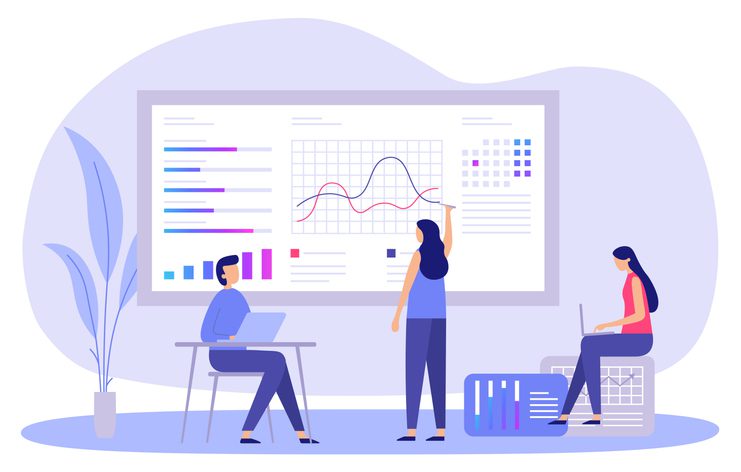As subscription businesses continue to grow at a rapid rate (500% in the last seven years), so do the revenue recognition challenges and compliance bottlenecks. While ERP software is often thought of as an answer to these challenges faced by subscription companies, is it really the best solution?
In this post, we’ll take a close look at some of the pros and cons of an ERP solution and help you decide if an ERP can scale with your growing revenue recognition needs.
What is an ERP?
ERP, or enterprise resource planning, is software designed to manage critical business activities such as accounting, procedurement, resource/project management, risk management, and supply chain operations. ERP systems can help businesses improve communication and collaboration between departments that manage these critical business processes. In addition, it can include performance management to help report an organization’s results against plan and predict future results.
One of the more important benefits of ERP software is that it can help businesses automate their revenue recognition process, which becomes increasingly complex for growing businesses. While ERP systems can provide a number of benefits, they are designed to meet the needs of multiple industries and are not necessarily customized for one particular segment. One major shortcoming in ERP systems is that they are not designed for the unique needs of a subscription/SaaS revenue model.
What are the shortcomings of ERP Software?
ERP systems are notoriously expensive and often require a large up-front investment.
Cost is a substantial deterrent to purchasing an ERP system and when evaluating whether ERP is right for your business, here are multiple factors that can drive up the cost of implementing and maintaining the system:
- Upfront integration
- Customization if needed
- Expensive subscription and licensing costs
- Complex user interface requiring third party vendors for training and support
- Add-ons needed to keep up with business changes
Many hyper-growth companies or subscription businesses that want to get efficient in revenue recognition and GAAP-compliant sooner than later are in a crossroads to either:
- Purchase or upgrade to an expensive ERP system or;
- Find a specific revenue recognition solution that can integrate with any existing tech stack
While ERP can help automate multiple business processes, companies that have non-ERP accounting systems may not have to upgrade to an expensive ERP solution just to address revenue recognition. Instead, they can go with a cost-efficient revenue recognition solution that is more flexible and can seamlessly integrate with any system, therefore, extending the life of the existing tech stack.
It takes a long time to implement ERP.
ERP systems are often complex and take a significant amount of time to implement. While there is no standard timeline for implementing ERP systems due to many varying factors, the average end-to-end implementation effort can take 6 to 18 months. Several circumstances driving the ERP implementation timeline include:
- Customization and add-ons needed which can be industry-specific or in response to business changes
- Size and complexity of the business such as volume of transactions and number of revenue streams
- Multiple systems used throughout the organization for integration
- Complexity of the ERP system being installed
- Number of users
- Transfer from legacy systems including data
The top reason from the above list that makes revenue recognition particularly challenging for subscription/SaaS companies is customization. ERP systems typically require a lot of customization to fit the specific needs of the subscription revenue model. Additionally, ERP systems often need to be integrated with other business applications, further delaying the time to value for ERP implementation.
Part of the ERP implementation process also includes training internal users on how to access and operate it. With the extensive customizations often required for subscription/SaaS companies, getting the team up-to-speed can elongate the implementation process, as opposed to a solution that is designed specifically for SaaS revenue recognition.
ERP systems are not flexible enough to accommodate complex subscription/SaaS revenue models.
ERPs were not necessarily built for the subscription industry. They are not agile enough, nor were they designed to accommodate the complex revenue models of subscription/SaaS companies.
In a traditional business, customers make a one-time purchase and receive goods or services on an as-needed basis, and for this use case, ERP systems do exactly what they were designed to do.
In contrast, subscribers commit to payments for a service on a recurring basis, typically monthly or annually and in this customer-for-life model, many changes can be made to the subscription contracts, therefore, creating a number of complexities that ERP systems are simply not designed to handle. Contract modifications can include changes such as upgrades, downgrades, cancellations and renewals. Additionally, customers can purchase multiple products and services in a bundled arrangement and accounting for the different performance obligations for revenue recognition can be challenging with conventional ERP systems. These complexities combined with high volume of transactions can easily overwhelm the capabilities of today’s ERP systems. As a result, companies with a subscription model often find themselves needing a separate revenue recognition solution specifically built to handle increasingly complex revenue models as they grow. That’s exactly why we built Chargebee RevRec, to best fit the needs for subscription/SaaS companies.
Scale your business with the right revenue recognition tool
As discussed above, revenue recognition for growing companies with subscription or recurring revenue models is far more complex than that of a non-subscription business model.
Maintaining revenue recognition manually is burdensome to an accounting and finance team, and it is inefficient and prone to errors. Automation is the key to scalability and here are a number of factors to consider in evaluating a revenue recognition solution.
- GAAP Compliant (ASC 606 / IFRS 15)
- Integration with Source Systems for up-to-date revenue impacting data
- Controlled Revenue Subledger, expediting the accounting close and generating revenue journal entries to support the general ledger
- Flexible to handle Contract Changes
- Advanced Revenue Recognition Scenarios
- Comprehensive Reporting and Analytics (GAAP Reports and SaaS KPIs)
To learn more, check out our ebook ‘How to Choose a Revenue Recognition Solution that Scales with Your Business’ where we deep dive into considerations for evaluating a revenue recognition solution for your business.
Without a flexible revenue recognition tool that’s scalable and traceable, subscription/SaaS businesses may find it difficult to accurately account for their revenue and stay ahead of compliance requirements. Chargebee’s RevRec does all of this and more.
To learn how Chargebee RevRec can help automate revenue recognition for your business, talk to one of our specialists today.

